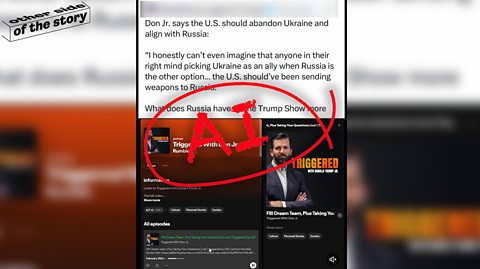Few things in recent times have set social media spinning quite like the row between US President Donald Trump and Ukrainian President Volodymyr Zelensky at the White House back in February. It prompted multiple false or misinformed posts which have helped to spread fake news to millions of people. Here’s a rundown of some of them.

AI videos of Donald Trump and Volodymyr Zelensky
Shortly after February's meeting in the White House, the internet was flooded with fake videos of Trump and Zelensky's meeting, including one that showed Zelensky punching Trump, and another where Trump claims Zelensky bought his suit on Temu.
Artificial intelligence has improved a lot in recent times, and can look very realistic, so it's important to take a step back before sharing videos like this with your friends or family. It's a good idea to look out for any signs that something may be artificially generated, including:
- Lips not moving in sync with the words
- Unusual phrasing or mispronunciations of words
- Unnatural movements or actions
Some accounts will use AI generated content for comedy, and they might label it as such. Look out for any notes in the caption as this could be a clue that something has been created for fun, but if something fun is shared in the wrong context then it might cause trouble.
When breaking news of this nature happens, it's important to get your information from a reliable source, such as the website of a reputable news outlet or their verified social media account.


Trump Jr's AI podcast
It had been hoped that Trump's meeting with Zelensky would strengthen ties between Ukraine and the US.
However, an audio clip that had been circulating prior to the confrontation is of a supposed podcast featuring President Trump's son, Donald Trump Jr. where he 'says' "I honestly can't even imagine anybody in their right mind picking Ukraine as an ally when Russia is the other option… The US should've been sending weapons to Russia."
BBC Verify journalist Shayan Sardarizadeh says that the fact that the podcast episode is currently not listed on Spotify should be a red flag as to its authenticity. Shayan reached out to Professor Hany Farid, from GetReal Labs, the world's leading authority on malicious synthetic content and deepfake detection, who verified that the audio clip is AI-generated.
AI generated videos may be easier to identify due to some of the signs we've listed, however, AI generated audio can be harder to verify. Fake news thrives at a time of war, so if you hear anything that causes you alarm, then it's probably a good idea to check the facts before believing what you've listened to.


Memes
The Zelensky/Trump argument also spawned a whole host of new memes that have been used across the web, poking fun at the situation. Memes are images, videos or pieces of text that spread rapidly through the internet, often following on from something that has happened in popular culture or the news.
While it can be fun to share memes, it is good to think about the consequences of sharing content like this; often if the meme is linked to politics it will be biased toward one political party over another, as we saw in last year's general election, and you might not get all the facts.
If memes and content with the same points of view are shared among friends it can lead to being trapped in an echo chamber, where you only see content from one side of the story, making it seem like the internet is reacting in just one way, instead of presenting alternative views. It is always good to be open to other opinions and get the full picture which may involve doing some wider research.
This article was published in March 2025.


Not sure if the news you’re seeing on social media is true or false? Can you always tell if the things you see online are real or fake? Learn how to get the other side of the story with our quizzes, videos and explainers.


